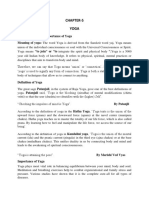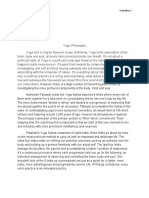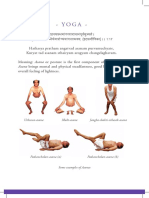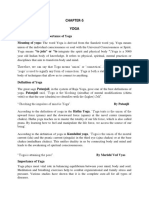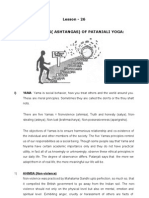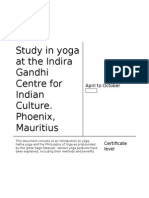Yoga - 2
Yoga - 2
Uploaded by
rs5300974Copyright:
Available Formats
Yoga - 2
Yoga - 2
Uploaded by
rs5300974Original Title
Copyright
Available Formats
Share this document
Did you find this document useful?
Is this content inappropriate?
Copyright:
Available Formats
Yoga - 2
Yoga - 2
Uploaded by
rs5300974Copyright:
Available Formats
2. Describe the Ashtanga Yoga in detail.
Answer:
Introduction: Ashtanga Yoga, often referred to as the "eight-limbed path," is a transformative
spiritual practice rooted in ancient Indian philosophy. Developed by the sage Patanjali, it is
outlined in his work, The Yoga Sutras, and is aimed at achieving physical, mental, and spiritual
harmony. Through a step-by-step journey, Ashtanga Yoga guides practitioners toward self-
realization and inner peace, making it a holistic approach to well-being and self-discipline. Its
eight components, or limbs, offer a path that enables an individual to cultivate balance, strength,
and clarity on both physical and spiritual levels.
The Eight Limbs of Ashtanga Yoga
1. Yama (Ethical Guidelines): The first limb, yama, represents moral and ethical guidelines that
encourage positive relationships with the outside world. These include:
o Ahimsa (non-violence): Emphasizing compassion toward others.
o Satya (truthfulness): Being honest in thoughts, words, and actions.
o Asteya (non-stealing): Avoiding exploitation or jealousy.
o Brahmacharya (moderation): Exercising control over desires.
o Aparigraha (non-possessiveness): Releasing attachment to material things.
2. Niyama (Personal Observances): Niyama refers to personal observances that promote
discipline and spiritual growth. The five niyamas are:
o Shaucha (purity): Maintaining cleanliness of the body and mind.
o Santosha (contentment): Accepting life as it is.
o Tapas (self-discipline): Engaging in self-control.
o Svadhyaya (self-study): Cultivating self-reflection and studying sacred texts.
o Ishvara Pranidhana (devotion to a higher power): Surrendering to a divine presence.
3. Asana (Physical Postures): Asana refers to the physical postures practiced in yoga. It
strengthens the body, enhances flexibility, and prepares the mind for meditation. Regular
practice of asanas leads to control over the physical body and builds endurance, which is
crucial for the later stages of meditation.
4. Pranayama (Breath Control): Pranayama involves breathing techniques that help regulate the
flow of energy within the body. Controlled breathing can calm the mind, increase
concentration, and purify the body. Techniques include Ujjayi (victorious breath), Kapalabhati
(skull shining breath), and Nadi Shodhana (alternate nostril breathing).
5. Pratyahara (Withdrawal of Senses): Pratyahara refers to withdrawing the senses from
external distractions, directing them inward. This practice allows one to gain control over
cravings and impulses, preparing the mind for deeper meditation by shifting attention away
from the external world.
6. Dharana (Concentration): Dharana is the practice of focused concentration on a single point
or object. It helps calm the mind and build the strength needed for sustained focus, laying the
groundwork for meditation. Objects of concentration might include a mantra, a specific
image, or even the breath.
7. Dhyana (Meditation): Dhyana represents a state of deep, uninterrupted meditation where
the mind is entirely absorbed in the object of focus. This stage transcends conscious
concentration and opens the door to profound insights and inner peace.
8. Samadhi (Enlightenment): The final limb, Samadhi, is a state of ultimate bliss and self-
realization. Here, the practitioner experiences unity with the universe, transcending ego and
individual identity. Samadhi is seen as the goal of Ashtanga Yoga, where one attains a state of
inner peace and spiritual liberation.
Conclusion: Ashtanga Yoga, with its eight interconnected limbs, is more than just a set of
practices; it is a journey toward holistic well-being and spiritual enlightenment. Each limb plays a
crucial role in fostering self-awareness and discipline, creating a foundation for personal and
spiritual growth. Practicing Ashtanga Yoga allows individuals to explore and nurture their mind,
body, and soul, ultimately leading them toward a balanced, harmonious, and enlightened life.
Through commitment and discipline, Ashtanga Yoga guides practitioners on a transformative path
that cultivates inner peace and connects them to the essence of their true self.
You might also like
- 11 Physical Education - Yoga-NotesDocument11 pages11 Physical Education - Yoga-NotesAtu Kaushal100% (7)
- Introduction To Yoga PhilosophyDocument33 pagesIntroduction To Yoga PhilosophyRahul Valiyakulangara100% (1)
- Thelema 101 YogaDocument10 pagesThelema 101 YogaLuke.418No ratings yet
- Yogic Philosophy EssayDocument6 pagesYogic Philosophy EssayCNo ratings yet
- Excel Word Practice Exercise SolutionsDocument9 pagesExcel Word Practice Exercise SolutionsAsif Abdullah KhanNo ratings yet
- BioBridge Quick Start Guide - Lenel OnGuard (OpenAccess)Document20 pagesBioBridge Quick Start Guide - Lenel OnGuard (OpenAccess)brandonNo ratings yet
- Yoga and Happiness B Com Sem 2Document6 pagesYoga and Happiness B Com Sem 2baxolaj623No ratings yet
- Ashtanga Yoga - PatanjaliDocument2 pagesAshtanga Yoga - PatanjaliShruti KhanduriNo ratings yet
- Yoga and MeditationDocument9 pagesYoga and MeditationSahil AnsariNo ratings yet
- Module VIDocument22 pagesModule VIabhiramikunnath02No ratings yet
- Yoga & Lifestyle (1)Document9 pagesYoga & Lifestyle (1)xp.madhumaltighoshNo ratings yet
- Ashtang YogaDocument2 pagesAshtang Yogaaryanpal2082006No ratings yet
- Patanjali Yoga Sutra: Dharma FebruaryDocument3 pagesPatanjali Yoga Sutra: Dharma FebruaryMohammad AbdoNo ratings yet
- PE Module 5Document13 pagesPE Module 5Leslie QwerNo ratings yet
- Ashtanga Yoga of PatanjaliDocument8 pagesAshtanga Yoga of PatanjaliAVINASH KEDIANo ratings yet
- Yoga Notes Edited OEDocument23 pagesYoga Notes Edited OE4NM20EC128 SUMUKHA S ACHARYANo ratings yet
- Book Inside Pages Final Part 2Document77 pagesBook Inside Pages Final Part 2Rajiv Gulati100% (1)
- Yoga: Case StudiesDocument39 pagesYoga: Case StudiesRorro Saavedra100% (2)
- Topic-2 Introduction To Ashtanga YogaDocument8 pagesTopic-2 Introduction To Ashtanga YogaippirpsNo ratings yet
- Chapter 3 YogaDocument64 pagesChapter 3 Yogadevarshdoshi1305No ratings yet
- 11 Physical Education - Yoga-NotesDocument11 pages11 Physical Education - Yoga-NotesAbhinav Kumar67% (3)
- Class Notes: Class: XI Topic: YOGA/SKV Subject: Physical EducationDocument8 pagesClass Notes: Class: XI Topic: YOGA/SKV Subject: Physical EducationDisney DoreamonNo ratings yet
- Introduction To Yoga Philosphy PDFDocument13 pagesIntroduction To Yoga Philosphy PDFNishant DhimanNo ratings yet
- Introduction To Yoga Philosphy PDFDocument13 pagesIntroduction To Yoga Philosphy PDFNishant DhimanNo ratings yet
- E-Content-Module 17-Yoga Techniques For Improving Intelligence IDocument6 pagesE-Content-Module 17-Yoga Techniques For Improving Intelligence Ivasivijai1980No ratings yet
- YOGA24Document13 pagesYOGA24Sree Lakshmi TNo ratings yet
- Yoga Open NotesDocument8 pagesYoga Open NotesInsight MndyNo ratings yet
- The 8 Limbs of YogaDocument3 pagesThe 8 Limbs of YogaBhakti and YogaNo ratings yet
- Untitled DocumentDocument5 pagesUntitled Documentd65rpd7kbkNo ratings yet
- Explain Ashtanga Yoga and Its Eight Limbs: 1. YamaDocument3 pagesExplain Ashtanga Yoga and Its Eight Limbs: 1. Yamars285225100% (1)
- Assignment 7 For FDP On Yogadarshan Submitted by DR Devasia Muruppath Antony (Devasiamantony@hinducollege - Ac.in)Document2 pagesAssignment 7 For FDP On Yogadarshan Submitted by DR Devasia Muruppath Antony (Devasiamantony@hinducollege - Ac.in)Devasia M AntonyNo ratings yet
- Prachi Ashtang YogaDocument18 pagesPrachi Ashtang YogaArushi BhargawaNo ratings yet
- YogaDocument34 pagesYogaManika RaiNo ratings yet
- Indian Approaches To PersonalityDocument14 pagesIndian Approaches To PersonalityShanthala RaoNo ratings yet
- PATANJALI YOGA AssignmentDocument4 pagesPATANJALI YOGA AssignmentsodumsuvidhaNo ratings yet
- CLASS-11 - PHY-ED. - CHAPTER-5. - Physical Fitness AndwellnessDocument13 pagesCLASS-11 - PHY-ED. - CHAPTER-5. - Physical Fitness AndwellnessIshmeet KaurNo ratings yet
- CH 3Document41 pagesCH 3देवेश पटेलNo ratings yet
- 8 Tangga Yoga Prenatal GentleDocument5 pages8 Tangga Yoga Prenatal Gentlewiulannababan2003No ratings yet
- Hatha Yoga Is One of The Most Widely Practiced Forms of Yoga in The WorldDocument2 pagesHatha Yoga Is One of The Most Widely Practiced Forms of Yoga in The WorldPadma KathiNo ratings yet
- LSM Lesson 26 DoneDocument5 pagesLSM Lesson 26 DoneKaran SabnaniNo ratings yet
- YOGADocument38 pagesYOGADhruv Damree100% (1)
- Project File - YogaDocument10 pagesProject File - YogaLucky gagsNo ratings yet
- Laya Yoga OBJECTTIVEDocument4 pagesLaya Yoga OBJECTTIVEMohan Kumar HNo ratings yet
- 11th YogaDocument3 pages11th Yogatyagigame10No ratings yet
- Yoga StressDocument2 pagesYoga StressManishaNo ratings yet
- Pysical Education Chapter - 3 YogaDocument7 pagesPysical Education Chapter - 3 Yogasiege gamerNo ratings yet
- Yoga 2Document31 pagesYoga 2avik mukherjeeNo ratings yet
- Unit - 1 YogaDocument6 pagesUnit - 1 YogaKhushi NMNo ratings yet
- chapter 3 yogaDocument38 pageschapter 3 yogajashithshetty3No ratings yet
- Yoga OverviewDocument2 pagesYoga OverviewElsa NievesNo ratings yet
- Philosophical Foundation of YogaDocument30 pagesPhilosophical Foundation of YogaAtu Kaushal100% (1)
- Chapter 3 YogaDocument38 pagesChapter 3 Yogayugansh sharmaNo ratings yet
- Yoga Proficiency BadgeDocument26 pagesYoga Proficiency Badgehariharan3331.d100% (1)
- Relevance of Yoga in Modern TimesDocument59 pagesRelevance of Yoga in Modern TimesMallika P. Raman100% (3)
- Five NiyamasDocument2 pagesFive Niyamasslythedor.valdez.diangelo.mkNo ratings yet
- Ashtang YogaDocument7 pagesAshtang Yogahinakhan602No ratings yet
- Rāja Yoga: Advaita VedantaDocument7 pagesRāja Yoga: Advaita VedantaHamidreza MotalebiNo ratings yet
- CHAPTER-5 XIth YOGADocument37 pagesCHAPTER-5 XIth YOGAshivangi BiswasNo ratings yet
- Patanjali's Eightfold Path of YogaDocument4 pagesPatanjali's Eightfold Path of YogaRahul KhuranaNo ratings yet
- Lesson 3 8 Limbs Yoga 1Document48 pagesLesson 3 8 Limbs Yoga 1stephcallejagonzalesNo ratings yet
- Registration & Notices On The RegisterDocument46 pagesRegistration & Notices On The RegisterZoey ChangNo ratings yet
- Trillanes Vs Castillo MarigomenDocument3 pagesTrillanes Vs Castillo MarigomenLaarnie Linggayo100% (3)
- African Gender Scholarship:: Concepts, Methodologies and ParadigmsDocument7 pagesAfrican Gender Scholarship:: Concepts, Methodologies and ParadigmsMila PimentelNo ratings yet
- Paediatric Antibiotic TeddyDocument1 pagePaediatric Antibiotic Teddyayu fitrianiNo ratings yet
- Humss - Creative Writing - Q2 - Mod7 - W4 - Staging Modalities and Envisioning The ScriptDocument17 pagesHumss - Creative Writing - Q2 - Mod7 - W4 - Staging Modalities and Envisioning The ScriptSHERMAE ANNE JANE ROLAND100% (1)
- Final DILR SmaDocument2 pagesFinal DILR SmaNisar AlamNo ratings yet
- 6.5.2 Ch7 HW 1-2 Pert CalcsDocument3 pages6.5.2 Ch7 HW 1-2 Pert CalcswilchaNo ratings yet
- Case StudyDocument2 pagesCase StudyMahnoor KhalidNo ratings yet
- Vector-Calculus Class Note Vector-Calculus Class NoteDocument47 pagesVector-Calculus Class Note Vector-Calculus Class NoteSuraj Gautam100% (1)
- OB Chapter 3Document62 pagesOB Chapter 3let it beNo ratings yet
- S2 2022 448945 BibliographyDocument6 pagesS2 2022 448945 Bibliographytyas.pawiroredjo1403No ratings yet
- How To Die With HumourDocument3 pagesHow To Die With HumourKhanh ĐanNo ratings yet
- MAPEH ARTS 4 DEMO DLP Q2 LatestDocument13 pagesMAPEH ARTS 4 DEMO DLP Q2 LatestVenson AgonoyNo ratings yet
- R Politics Ban Results ADocument2,828 pagesR Politics Ban Results AAnonymous N4O7A5f9No ratings yet
- Master Rotation Anm 2 ND YearDocument2 pagesMaster Rotation Anm 2 ND YearJyoti Prem UttamNo ratings yet
- Adiabatic LogicDocument68 pagesAdiabatic Logicahcheb100% (1)
- Abe 1935 Experimental Study On The Co-Relation Time SpaceDocument17 pagesAbe 1935 Experimental Study On The Co-Relation Time SpaceRafael Camilo Maya CastroNo ratings yet
- Let Your Goddess Grow! Free Online Book PreviewDocument67 pagesLet Your Goddess Grow! Free Online Book PreviewCharlene Proctor100% (4)
- Badly Broken MarzoukDocument68 pagesBadly Broken MarzoukHend MohamedNo ratings yet
- 1.9 Context Is Everything Self-Guided Lesson PresentationDocument11 pages1.9 Context Is Everything Self-Guided Lesson PresentationbayareッNo ratings yet
- Commercial Law Lecture 07-05-2019 PDFDocument12 pagesCommercial Law Lecture 07-05-2019 PDFเจียนคาร์โล การ์เซียNo ratings yet
- DUA Budget AssignmentDocument2 pagesDUA Budget AssignmentabisheyimramNo ratings yet
- Unmasking The Jezebel Spirit: John Paul JacksonDocument6 pagesUnmasking The Jezebel Spirit: John Paul JacksonTania Alejandra JoyNo ratings yet
- Evolution of ManagementDocument22 pagesEvolution of ManagementJohnlouie RafaelNo ratings yet
- 07 - Information Structure AnalysisDocument14 pages07 - Information Structure AnalysisFebiadrNo ratings yet
- Freemasonry TruthDocument25 pagesFreemasonry Trutheric parl100% (1)
- The Ultimate Photography Cheat BookDocument40 pagesThe Ultimate Photography Cheat BookTamás KádasNo ratings yet
- Curriculum: 2-YEAR Master of Business Administration (Mba) Programme (Distance Mode) 2015-2017Document29 pagesCurriculum: 2-YEAR Master of Business Administration (Mba) Programme (Distance Mode) 2015-2017Sayantani SamantaNo ratings yet
